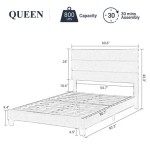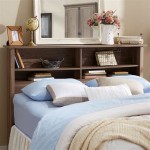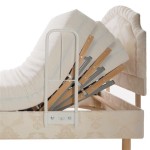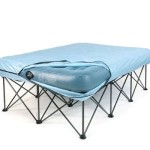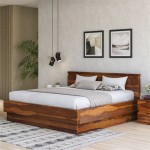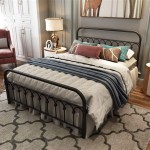How To Fit A Queen Size Bed In A Small Room
Maximizing space in a small room presents a significant challenge, particularly when incorporating a queen size bed. Queen beds, while offering ample sleeping space, consume a considerable footprint. However, with careful planning and strategic choices, it is indeed possible to accommodate a queen size bed in a smaller room without sacrificing functionality or aesthetics. This article outlines several strategies to effectively integrate a queen bed into a limited space, focusing on furniture selection, layout optimization, and vertical space utilization.
Prioritize Bed Frame Selection and Placement
The selection of the bed frame itself is paramount when dealing with a small room. Opting for a bed frame with minimal bulk is a crucial first step. Consider platform beds, which sit low to the ground and often lack a headboard or footboard, thereby reducing the overall space occupied compared to traditional bed frames. Metal frames, known for their slim profiles, are also a viable option. Avoid bulky, ornate frames with large headboards and footboards as these can visually overwhelm the space and impede movement.
Furthermore, consider incorporating storage solutions directly into the bed frame. Bed frames with built-in drawers beneath the mattress provide valuable storage space, eliminating the need for a separate dresser or chest of drawers. This is particularly advantageous in small rooms where floor space is limited. Ensure the drawers are easily accessible even with the bed positioned against a wall. Some bed frames offer hydraulic lift mechanisms, allowing the entire mattress to be lifted, revealing a large storage compartment underneath. This option is excellent for storing seasonal items, bedding, or other less frequently used belongings.
The placement of the bed within the room is equally critical. The most natural instinct might be to center the bed against the longest wall. However, in a small room, this may not be the most space-efficient solution. Consider placing the head of the bed against a wall, leaving one or both sides accessible. This creates a walkway around the bed, preventing the feeling of being cramped. In extremely tight spaces, pushing the bed into a corner might be necessary, although this can make it difficult for the person sleeping on the inside to easily get in and out of bed.
Optimize Furniture Layout and Scale Down
Beyond the bed itself, other furniture pieces must be carefully selected and arranged to maximize space. Prioritize essential furniture items only. A minimalist approach is key. Instead of a large dresser, consider using a smaller nightstand with drawers for storage. Alternatively, floating shelves can provide storage without taking up floor space. Wall-mounted desks are also an excellent space-saving option, providing a workspace that folds away when not in use.
Scale is crucial. Choose furniture that is proportional to the size of the room. Oversized furniture will make the room feel even smaller. Look for narrow nightstands, smaller dressers, and chairs with slim profiles. Transparent furniture, such as acrylic chairs or glass-topped tables, can also create the illusion of more space by allowing light to pass through them. Avoid cluttering the room with unnecessary decorative items. Limit accessories to a few carefully chosen pieces that complement the overall aesthetic.
Consider multi-functional furniture. A futon or convertible sofa can serve as a seating area during the day and transform into an extra bed for guests. A storage ottoman provides seating and storage in one. These types of furniture pieces offer versatility and help to minimize the number of individual items needed in the room. Think about how each piece of furniture can serve multiple purposes to maximize its utility.
Utilize Vertical Space and Employ Visual Tricks
When floor space is limited, maximizing vertical space is essential. Install shelves above the bed to create additional storage. Open shelving can also serve as a display area for books, plants, and decorative items. Use tall, narrow bookcases to store belongings without taking up too much floor space. Ensure that shelves are securely mounted and that items are arranged in a visually appealing manner.
Hang mirrors to create the illusion of more space. Mirrors reflect light and make a room feel larger and brighter. A large mirror on a wall can visually double the size of the room. Strategically place mirrors to reflect windows or other sources of light. Consider using mirrored furniture, such as mirrored nightstands or dressers, to further enhance the effect.
Employing visual tricks can also make a small room feel larger. Use light and bright colors on the walls to reflect light and create an airy atmosphere. Avoid dark colors, which can make a room feel smaller and more enclosed. Choose bedding and curtains in light, neutral colors. Vertical stripes on walls or curtains can visually elongate the room. Keep the floor clear and uncluttered to create a sense of spaciousness. A well-placed rug can define the bed area and add visual interest without overwhelming the space.

20 Smart Ideas How To Make Small Bedroom Look Bigger

3 Furniture Layouts For A Small Bedroom Bless Er House

How To Arrange A Small Bedroom With Queen Bed

11 Ways To Make A Tiny Bedroom Feel Huge Huffpost Life

How To Arrange A Small Bedroom With Queen Bed

11 Ways To Make A Tiny Bedroom Feel Huge Huffpost Life

Small Bedroom Makeover Before After The Inspired Room

Stressed Out Over A Queen Bed In 10 X Bedroom Here S 8 To Help Michael Helwig Interiors

How Do I Place A Queen Size Sleigh Bed In Small Room Hometalk

5 Best Layouts For Small Bedrooms 13 Sqm Mf Home Tv
Related Posts
